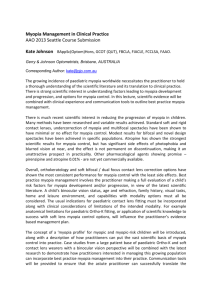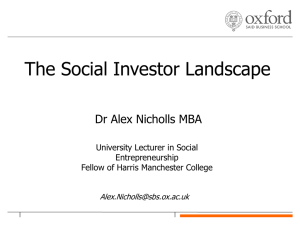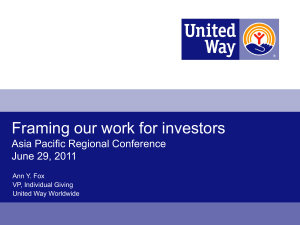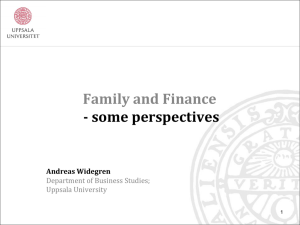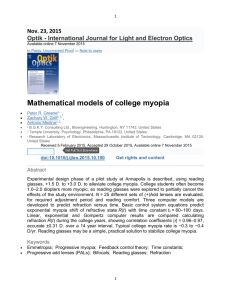Investor Myopia and The Current Global Crisis: A Post Keynesian View
advertisement
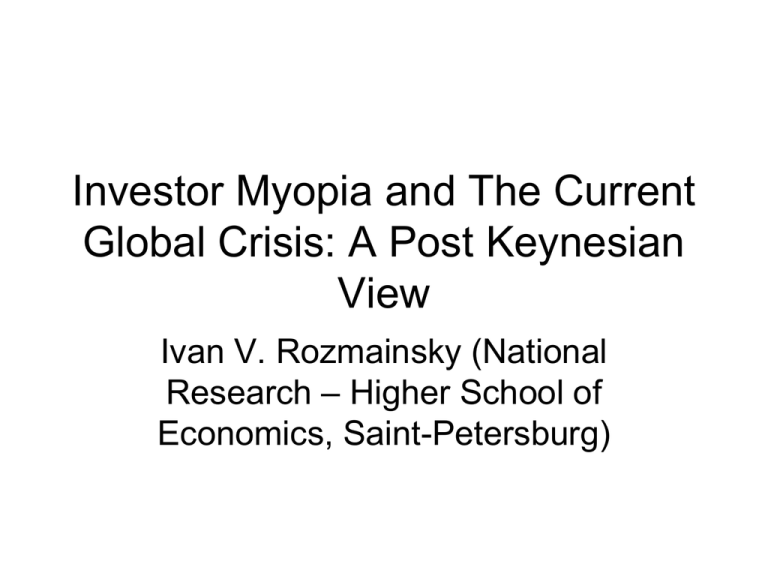
Investor Myopia and The Current Global Crisis: A Post Keynesian View Ivan V. Rozmainsky (National Research – Higher School of Economics, Saint-Petersburg) The main questions… • How to integrate uncertainty into macroeconomic analysis? • How to explain the current global crisis (or the “great recession”)? • How to link these two issues? The key word is investor myopia • Investor myopia is the extreme form of shorttermism. • Short-termism is the pessimistic under-weighting of expected future returns and/or the excessive discounting of expected future returns (Juniper, 2000). • Then investor myopia implies that agents exclude from the consideration values of future variables after some “threshold” time point. The consequences of investor myopia (part 1) • Entrepreneurs with investor myopia aspire to make money (a) by means of trade or various (stock, foreign exchange, real estate) speculation, (b) in the industries bearing quick income, or (c) within the framework of illegal sector. • Workers (employees) with investor myopia do not accumulate their human/health capital and rush for unskilled occupations, including activity within the framework of three just mentioned “spheres”. The consequences of investor myopia (part 2) • In general, investor myopia decreases demand for productive durable assets and increases demand for money and/or surrogate stores of value which are non-productive assets which do not perform function of means of payment, but serve as the stores of value (the examples of such stores are financial assets, the Old Masters, precious metals, antiques, etc). Investor myopia is, to some extent, similar to liquidity preference • Both investor myopia and liquidity preference can depress the real economy • Both phenomena generate “shift” to liquid non-productive assets. But nevertheless investor myopia is different from liquidity preference! • “Liquidity preference has to do with an urge for inaction, rather than action” (Dequech, 1999) • Then investor myopia has to do with “an urge for action bearing only short-term outcomes”. • It is a more long-run phenomenon than liquidity preference. It has institutional and cultural roots. Institutional roots of investor myopia (part 1) • “how we try to cope with uncertainty defines the system under which we live” (Rousseas, 1998). • Investor myopia can take place If and when institutions of this or that economic system fail to decrease significantly uncertainty, for example, when the State fails to enforce contracts. • Degree of uncertainty surrounding economic agents is a positive function of degree of legal contracts enforcement provided by the State. • The examples are some post-socialist countries like Russia. Institutional roots of investor myopia (part 2) • Lack of enforcement can increase opportunism • Opportunism - Unlike mainstream economics’ doctrine – can be changeable. • But increasing opportunism narrows planning horizon. • If agents do not trust each other they will not put into practice of any lengthy (and complex) activities; Increased opportunism instills psychology of participants of illegal sector in “ordinary” people. They begin to strive for short-term gains. The calculations of long-term outcomes can become an exception. • Therefore, investor myopia can be reaction on the increasing opportunism Cultural roots of investor myopia (part 1) • But opportunism itself can be concerned with culture. • The concepts of money manager capitalism and financialization are very important here! • Money manager capitalism is a type of capitalist economy where money/fund managers – including pension funds, insurance companies etc – dominate the financial markets and does the influence on the macroeconomy (such capitalism took place since 1980s). The money managers want to maximize the value of their assets over each short period and try to get short-term gains (Wray 2009; 2011). Cultural roots of investor myopia (part 2) • Furthermore, the evolution of money manager capitalism is inextricably linked with such phenomenon as financialization which is a “process where by financial markets, financial institutions, and financial elites gain greater influence over economic policy and economic outcomes” (Palley 2007). This process induces corporate managers to think essentially about short-term stock price dynamics in the prejudice of long-term profitability. • “Financial markets attract short-horizon speculative traders as these markets allow for sequential trading“ (Binswanger, 1999). Cultural roots of investor myopia (part 3) • Financialization transforms economic culture; it stimulates opportunism and destroys moral norms based on Christianity. • Money manager capitalism is a capitalism with culture which is “well-disposed” to the ideals of quick and shortterm enrichment almost at any costs. There can become the norm in the system where “there is a strong incentive to overstate actual earnings – by failing to recognize losses, by overvaluing losses, and through just plain fraudulent accounting” (Wray, 2011). • The natural outcome is “the rise of fraud as normal business procedure” (Wray, 2011). • So, the money manager capitalism is very conducive to investor myopia. Cultural roots of investor myopia (part 4) • Another dimension of the modern capitalism’ evolution – its transformation to the mass consumption society. This is society where the main goal of human activity is high and rising current consumption level. • "the Puritan ethic was not abandoned. It was merely overwhelmed by the massive power of modern merchandising" (Galbraith, 1958). In turn, merchandising and consumer credit can be considered as the main institutions of the mass consumption society (Goodwin et al. 2008). Both institutions increase value of the present time relative to the future time. Advertising-influenced and indebted people become oriented (more and more) to the short-term outcomes. Investor myopia is a natural outcome. Conclusion (part 1) • The main idea is that the persistence of the current global crisis can be explained by phenomenon of investor myopia. When agents exclude from the consideration values of future variables after some “threshold” time point they may refuse from investing in durable productive assets. • The underlying causes of investor myopia – unlike liquidity preference – have institutional and cultural nature and exert influence on the human behavior with time lags. Conclusion (part 2) • On the one hand, investor myopia is a reaction on the higher uncertainty due to ineffective institutions leading to a lack of enforcement or a lack of punishment for opportunistic behavior. These aspects are very serious problem in some post-socialist countries. • On the other hand, investor myopia is a reflection of values of economic culture emphasizing the importance of maximizing short-term financial gains and/or current consumption. These factors make (perhaps, insensibly) the current gains more and more important than the future ones in agents’ perception. • Therefore, the prolonged crises can be natural for the modern capitalist societies. Thank you very much • For attention!





